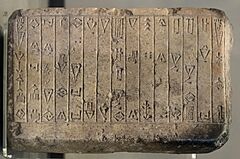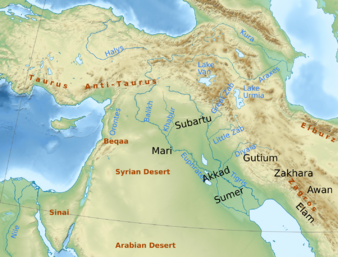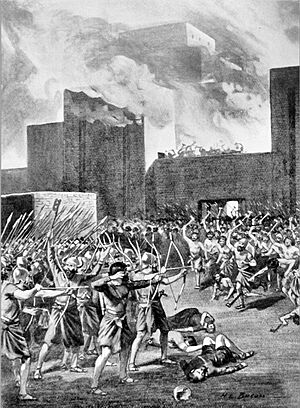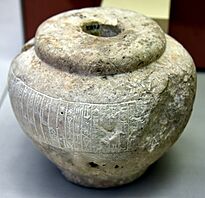Gutian people facts for kids
Bottom: Approximate location of original Gutium territory
The Guti (pronounced goo-tee), also called Gutians, were an ancient group of people from the Near East. Their home region was known as Gutium (Sumerian: 𒄖𒌅𒌝𒆠, GutūmKI or 𒄖𒋾𒌝𒆠, GutiumKI).
The Gutians were involved in conflicts with the Akkadian Empire. These fights are thought to have led to the collapse of the Akkadian Empire around 2000 BC. After this, the Guti took over southern Mesopotamia and formed their own ruling family, known as the Gutian dynasty of Sumer. The Sumerian king list suggests that the Guti ruled over Sumer for many years after the Akkadian Empire fell.
Later, around 1000 BC, people in lowland Mesopotamia started using the name Gutium more broadly. It came to include all of western Media, an area between the Zagros Mountains and the Tigris River. Many tribes and places to the east and northeast were often called Gutians or Gutium. For example, ancient Assyrian records used the term Gutians for groups known to be Medes or Mannaeans. Even as late as the time of Cyrus the Great of Persia, a famous general named Gubaru was called the "governor of Gutium".
Contents
Who Were the Gutians?
We don't know much about where the Gutians came from, their daily life, or their language. Ancient writings give us very few details. Also, no objects have been clearly identified as belonging to them.
The Gutian language itself is a mystery. We only know a few names of Gutian kings. Because of this, it's impossible to compare their language to others. The names of Gutian kings suggest their language was not closely related to other languages in the region, like Sumerian, Akkadian, Hurrian, Hittite, or Elamite. Most experts do not believe the Gutian king names are linked to Indo-European languages.
Gutian History and Rule
Early Mentions of the Gutians

The Gutians first appear in ancient texts from around the 25th to 23rd centuries BC. These texts are copies of inscriptions from Lugal-Anne-Mundu, a ruler of Adab. They mention the Gutians as one of the groups that paid tribute to his empire. These writings place the Gutians between Subartu in the north and Marhashe and Elam in the south.
Sargon the Great, who ruled around 2340–2284 BC, also listed the Gutians among the lands he controlled. He placed them between Lullubi, Armanum, and Akkad to the north, and Nikku and Der to the south. One ancient stone carving claims that Naram-Sin of Akkad's army of 360,000 soldiers defeated the Gutian king Gula'an. Even though the Gutians killed 90,000 of Naram-Sin's soldiers, he still won.
The epic story Cuthean Legend of Naram-Sin says that Gutium was among the lands attacked by Annubanini of Lulubum during the rule of Naram-Sin (around 2254–2218 BC). Records from the time of Shar-kali-sharri of Akkad show that in one year, he captured Sharlag, the king of Gutium. In another year, it was said that "the yoke was imposed on Gutium," meaning Gutium was brought under control.
Gutian Power in the 22nd Century BC
During the time of the Akkadian Empire, the Gutians slowly became stronger. They eventually set up their capital in the ancient city of Adab. The Gutians then took over Akkad. The King List tells us that their army also conquered Uruk to gain control of Sumer, around 2147–2050 BC. However, it seems that independent rulers soon appeared again in many city-states, especially Gudea of Lagash.
The Gutians also seem to have briefly taken over Elam around the same time, near the end of Kutik-Inshushinak's rule (around 2100 BC). On a statue of the Gutian king Erridupizir at Nippur, an inscription copies his Akkadian predecessors. It calls him "King of Gutium, King of the Four Quarters," which meant he ruled over a vast area.
The Weidner Chronicle, written around 500 BC, describes the Gutian kings as wild and unrefined:
Naram-Sin destroyed the people of Babylon. So, the god Marduk twice called the forces of Gutium against him. Marduk gave his kingship to the Gutian army. The Gutians were unhappy people who didn't know how to respect the gods. They were unaware of the correct religious practices.
Utu-hengal, the fisherman, caught a fish at the edge of the sea for an offering. That fish should not be offered to another god until it had been offered to Marduk. But the Gutians took the cooked fish from his hand before it was offered. So, by his great command, Marduk removed the Gutian army from ruling his land and gave it to Utu-hengal.
The End of Gutian Rule

The Sumerian ruler Utu-hengal, who was the Prince of the Sumerian city of Uruk, is credited in the King List with defeating the Gutian ruler Tirigan. He removed the Guti from the country around 2050 BC.
In his Victory Stele, Utu-hengal wrote about the Gutians:
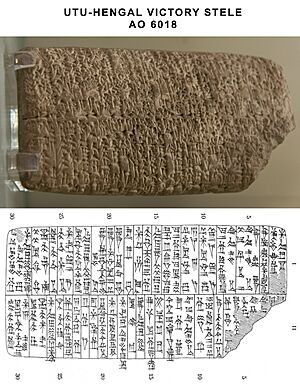
Gutium, the fanged snake of the mountain ranges, a people who acted violently against the gods, people who took the kingship of Sumer to the mountains, who filled Sumer with wickedness, who took a wife from her husband, who took a child from its parent, who created wickedness and violence within the country..."
After this, Ur-Nammu of Ur ordered Gutium to be destroyed. The 11th year of King Ur-Nammu's rule is also recorded as "Year Gutium was destroyed." However, according to a Sumerian epic, Ur-Nammu actually died in battle with the Gutians after his own army left him.
A Babylonian text from the early 2nd millennium BC describes the Guti as having a "human face, dogs’ cunning, [and] monkey's build." Some experts who study the Bible believe that the Guti might be the Qoa mentioned in the Book of Ezekiel 23:23. This part of the Bible was likely written in the 6th century BC.
Modern Theories About the Gutians
Some scholars believe that the historical Guti played a role in the creation of the Kurds as a people. However, others disagree with this idea.


